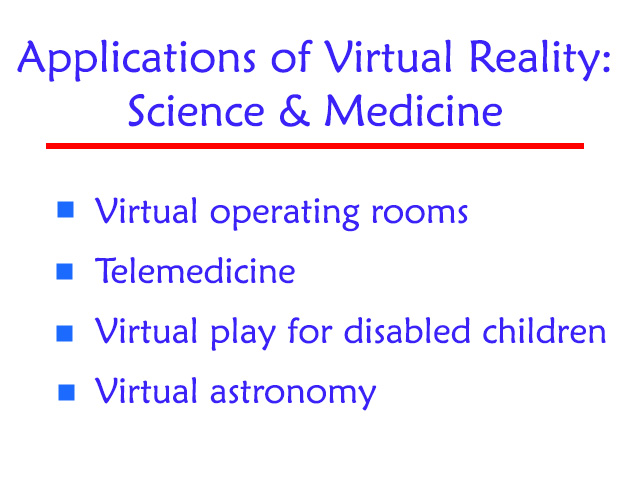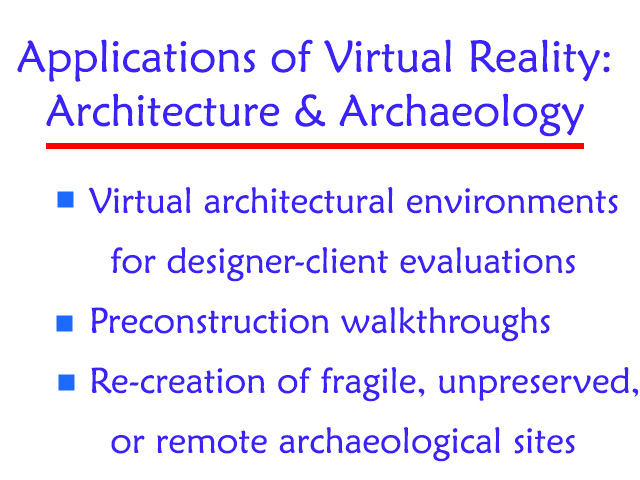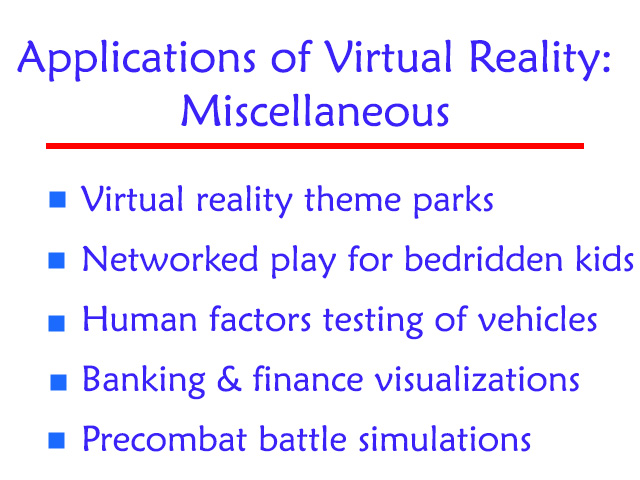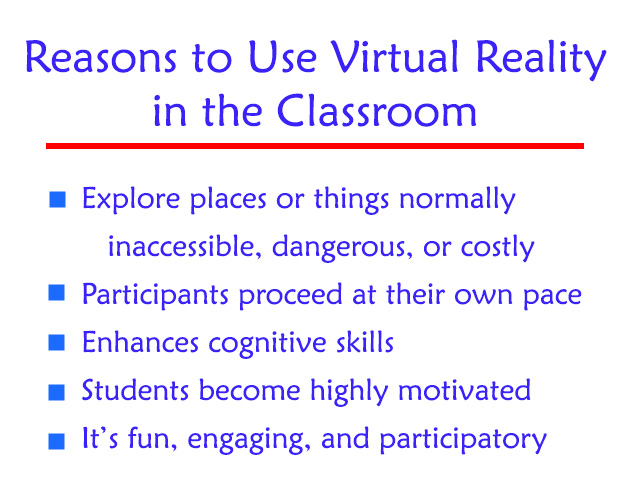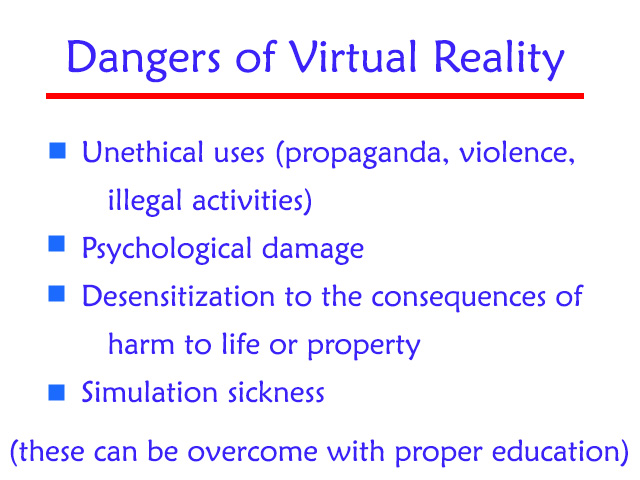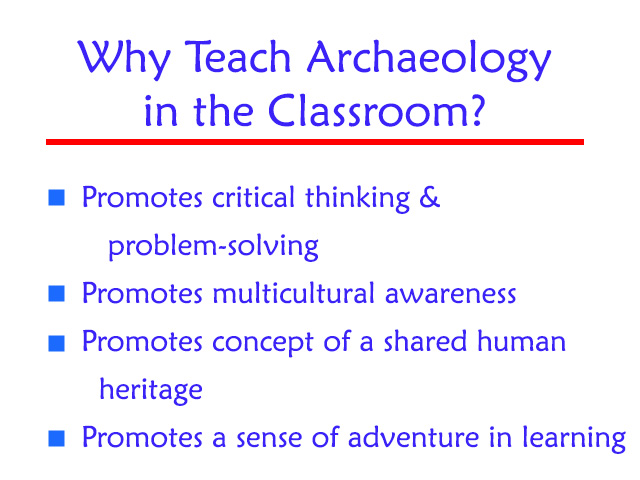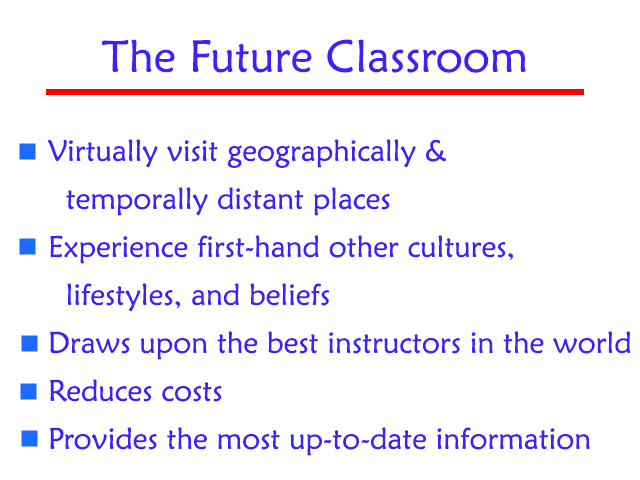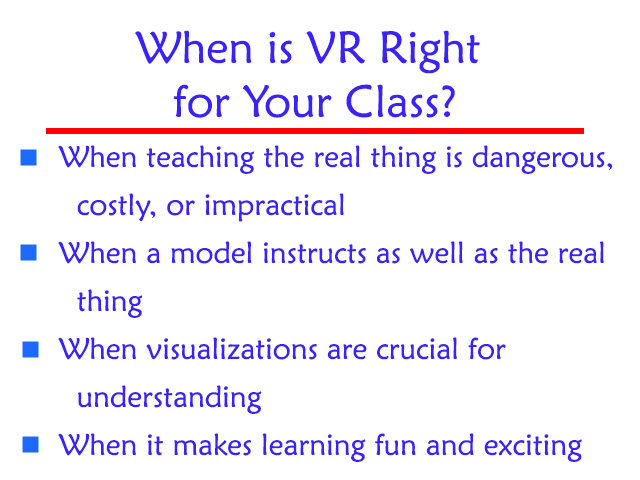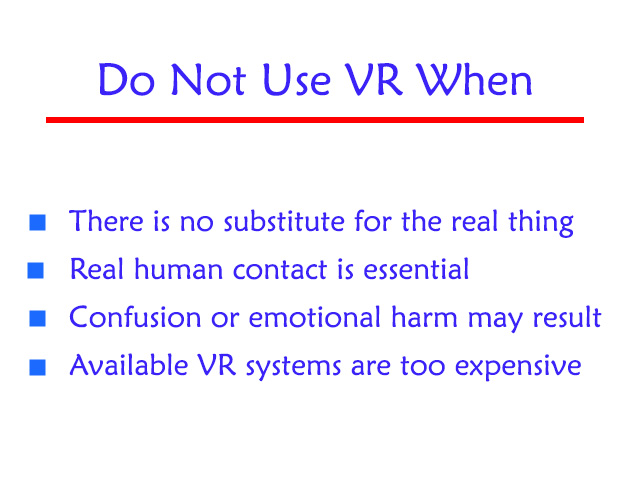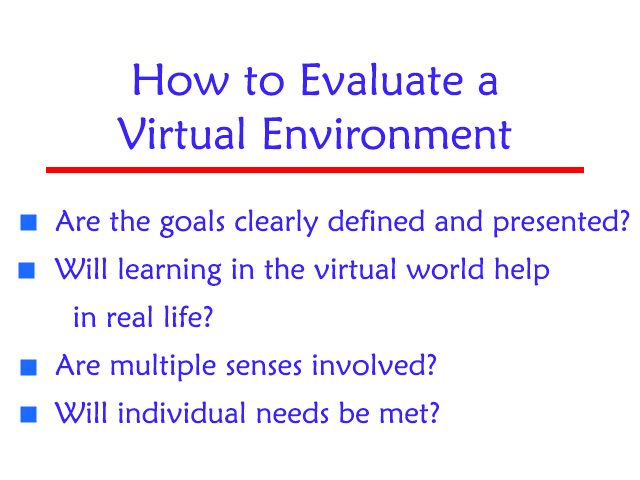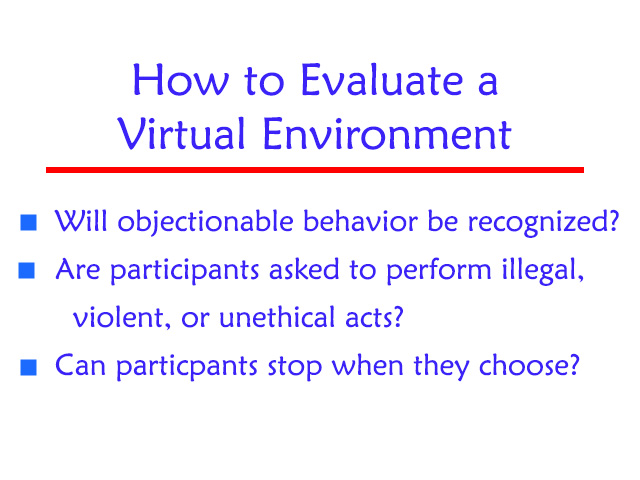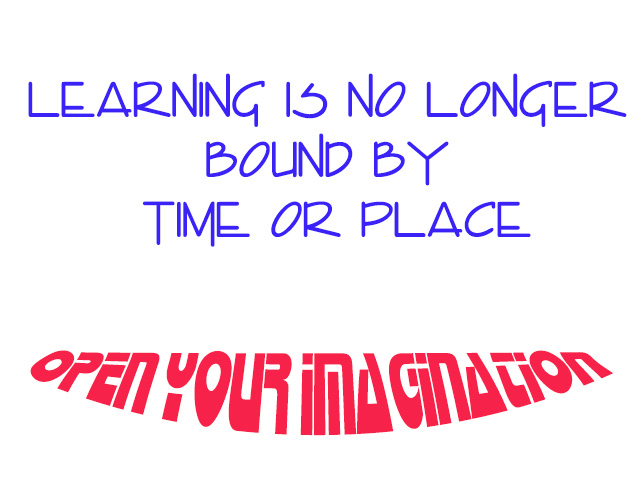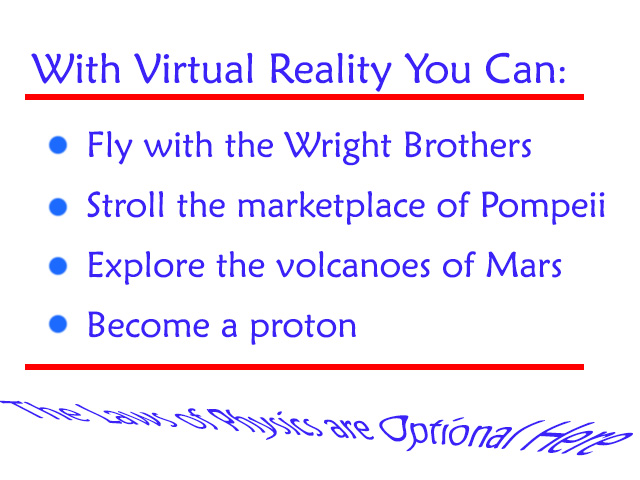 We've all heard about virtual reality (or VR). How many have had VR experiences? How many have used VR in their classroom? How can VR achieve its promised revolution? Let's jump right to extreme: VR can do more than recreate existing worlds, VR allows us to imagine and experience new ones. Virtual reality offers the ability to escape the actual world and visit mythical domains, unexplored territories, physically impossible locations, or past civilizations. Any topic or situation can be examined in a virtual setting. Sit next to the Wright Brothers in their historic flights, stroll through the marketplace of Pompeii, explore the volcanoes of Mars, test your wits against a dragon or sphinx, or discuss politics with George Washington. Become a proton and explore the dynamics of an atom. Hey, the laws of physics are strictly optional--you can be placed in an alien body and feel what it's like to live on a distant planet with different laws of motion or behavior. All this is possible and more. Stewart Brand of the MIT Media Lab says: "Junior deities, we want to be. Reality is mostly given. Virtual Reality is creatable." Lest you think I have blundered from educational fact into science fiction, let's examine the issues more closely.
We've all heard about virtual reality (or VR). How many have had VR experiences? How many have used VR in their classroom? How can VR achieve its promised revolution? Let's jump right to extreme: VR can do more than recreate existing worlds, VR allows us to imagine and experience new ones. Virtual reality offers the ability to escape the actual world and visit mythical domains, unexplored territories, physically impossible locations, or past civilizations. Any topic or situation can be examined in a virtual setting. Sit next to the Wright Brothers in their historic flights, stroll through the marketplace of Pompeii, explore the volcanoes of Mars, test your wits against a dragon or sphinx, or discuss politics with George Washington. Become a proton and explore the dynamics of an atom. Hey, the laws of physics are strictly optional--you can be placed in an alien body and feel what it's like to live on a distant planet with different laws of motion or behavior. All this is possible and more. Stewart Brand of the MIT Media Lab says: "Junior deities, we want to be. Reality is mostly given. Virtual Reality is creatable." Lest you think I have blundered from educational fact into science fiction, let's examine the issues more closely.
Throughout human development people have attempted to capture the essence of an experience and make it enjoyable for others. Cave paintings, storytellers, sculpture, theater, music, books all offer other views the world, other experiences, other beliefs, and other times, to stimulate the imagination, to instill wonder about the fantastic, and to speculate about the spiritual. Radio, television, and moving pictures continued a quest for increased realism and of being there. The same presentation techniques (and often the content as well) were used also to educate.
Visualization is a recognized means of presenting data and concepts, increasing comprehension and assimilation. Thus, in education, textbooks are illustrated and audiovisual materials are widely used. When a new way to visualize data and concepts becomes available it is natural to ask: "How can this new medium be incorporated productively into the learning process?" Virtual reality is a new medium. Although military, government, and scientific applications of simulations and some form of virtual reality have been around for decades, the application of this technology is largely unexplored for public education, allowing students to become absorbed by another reality and totally immersed in a learning activity.
A Brief history of virtual reality:
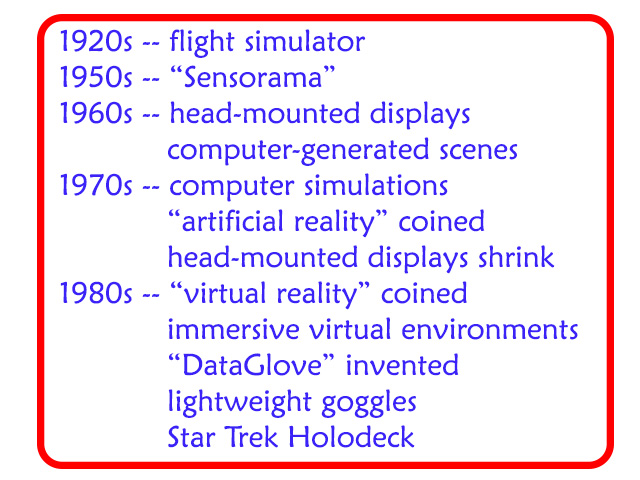 Although a new field, many of the underlying concepts and technologies of virtual reality have been around for a long time. Since the 14th century, artists and others have argued specifically that the more three-dimensional or realistic the depiction of an event the more engaging to the onlooker and the more believable the scenes or story would appear to the onlooker, at that time the religious or unbelievers.
Although a new field, many of the underlying concepts and technologies of virtual reality have been around for a long time. Since the 14th century, artists and others have argued specifically that the more three-dimensional or realistic the depiction of an event the more engaging to the onlooker and the more believable the scenes or story would appear to the onlooker, at that time the religious or unbelievers.
- 1920s -- Link Corporation developed training devices that simulated fighter plane cockpits. The full-sized mock-ups were mounted on motion platforms that could pitch and yaw to pilots actions.
- late 1950s -- cinematographer Morton Heilig created a simulator known as Sensorama, which could generate city smells, wind sensation, and vibration as a participant sat on a motorcycle and went on a simulated ride through New York City. This device had many of the features of a VR system except that the route was fixed and the experience was not truly interactive, but the complete use of senses has not been duplicated since.
- 1960s -- the status of the pioneer of VR is often given to Ivan Sutherland (also dubbed the father of computer graphics), who first proposed the use of stereographic head-mounted displays in the early 1960s whereby users could look around a computer-generated room by turning their head. In 1968, he and David Evans founded a company to produce computer-generated scenes for use in simulators to replace video camera-based scenes.
- early 1970s -- Frederick Brooks at the Universiy of North Carolina Chapel Hill had users handling graphic objects with a mechanical manipulator. In 1972, General Electric's Electronics Laboratory built for the Navy the first flight simulator that used computers; three screens gave pilots 180o simulated vision.
- early 1970s -- Myron Krueger coined the term "artificial reality" and began developing computer-controlled responsive environments eventually called Videoplace. It allowed the user's body to be captured by video camera in real-time and represented as a silhouette on a large screen in a darkened room. Using image processing techniques to detect silhouette edges, users could "finger-paint" by holding up a finger and moving it. A trail of colored paint appeared on the video screen following the movements of the finger; holding up all five fingers erased it. This was true interaction in which the computer was almost secondary if not passive, while the user became the focus.
- late 1970s -- the MIT Media Lab developed the Aspen movie Map, a video simulation of a drive though Aspen, Colorado, in which participants could drive down a street and enter and explore buildings. And, the complexity of fighter aircraft and supersonic speeds made split-second decisions critical to the survival rate of military pilots. In response, in 1979, the military constructed head-mounted displays that directed scenes directly into pilots eyes, eliminating cumbersome and expensive projection systems.
- 1980s -- rapid changes to VR technology and applications emerged. Jaron Lanier, a founder of VPL Research Inc., is credited with coining the expression "virtual reality." He used the term to distinguish between the immersive environments he created and traditional computer simulations. Thomas Zimmerman, co-founder of VPL worked with Lanier to develop the DataGlove in 1985, for grasping computer-generated objects in virtual worlds.
- 1980s -- artist Vincent John Vincent and computer programmer Francis MacDougall developed the Mandala Virtual Reality System allowing individuals to make music, play, create visual art, and communicate in a computer-based environment.
- 1980s -- Michael McGreevy and colleagues at NASA developed goggles that allowed the wearer to look around a graphic landscape portrayed on a computer screen. The goggles were much lighter, simpler, and cheaper than previous HMDs. Also, NASA assembled a virtual environment in which users could issue voice commands, hear synthesized speech and 3D sounds, and grab and manipulate 3D objects with their hands. Communication and feedback with a computer-simulated environment was direct, no contact with computer was needed.
- 1980s -- when the University of North Carolina decided to design a new research facility, the institution built a 3D simulation of the architecture instead of traditional balsawood models. Designers were able to look down corridors and into labs. Then they hooked up a treadmill and movable handlebars to the computers to simulate actual walking down the halls and turning into rooms.
- 1980s -- of course, also in the 1980s, Star Trek Next Generation used a Holodeck for crew entertainment, a computer-generated environment that used holographic figures and permitted players to participate actively in a completely simulated environment without being able to tell the difference between a real object or character and simulated ones.
- 1990s -- in 1992, the movie Lawnmower Man introduced the concept of VR to the public.
- (ed note 9/25/19: see also our more detailed and up-to-date history of virtual reality for cultural heritage)
Definitions of virtual reality:
There is no universally accepted definition of virtual reality. Because so many terms are used in the scientific literature and the popular media to describe the concept, VR has become a catchphrase for everything from visually coupled systems, desktop flythrough experiences, artificial realities, telepresencing, cyberspace travel, and synthetic environments. From true virtual worlds, to microworlds and cartoon worlds VR has become synonymous with any computer-generated environment that you can get into, anything that fakes a real world experience or viewpoint.
VR refers to a computer-generated immersive, multisensory experience that provides the user with an illusion of being in a real three-dimensional or environment. Virtual environments incorporate into their models of reality perceptual and physiological sensations; color, texture, lighting, acoustic and atmospheric cues; animated sequences; virtual objects; and images. VR lets you navigate and view three-dimensional worlds in real time, with six degrees of freedom--forward and back, up and down, left and right, pitching up and down, angling left and right, and rotating left or right. It is a clone of physical reality. Or to put it another way:
VR as an immersive, multisensory, interactive experience generated by a computer and characterized by the illusion of participation in a synthetic environment rather than external observation of such an environment. To induce a real world sensation, virtual visitors interact with computer-generated objects as well as artificial or actual persons. The virtual world can be a representation of abstract data, events, or a photorealistic visualization of actual situations. The sensation of reality is given by stereoscopic images, binaural sound, textures, and the ability to manipulate objects as if stepping through the computer screen into a new or parallel reality.
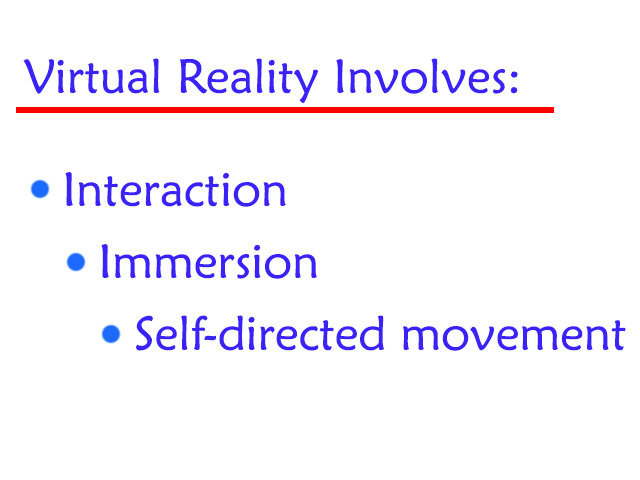 Thus, three elements make the complete VR experience--interactiveity, immersion, and self-directed movement. Interaction is moving objects or yourself around the space. Moving objects, like in video games involve no immersion; immersion is totally or mostly believing you are part of the spatial experience. Simulation emphasizes immersion, that is, deceiving your senses into believing that they are physically experiencing something. But immersion alone, as in some ride simulators, does not necessarily involve interaction. Increased believability comes with increased degrees of interaction, immersion, and self-direction.
Thus, three elements make the complete VR experience--interactiveity, immersion, and self-directed movement. Interaction is moving objects or yourself around the space. Moving objects, like in video games involve no immersion; immersion is totally or mostly believing you are part of the spatial experience. Simulation emphasizes immersion, that is, deceiving your senses into believing that they are physically experiencing something. But immersion alone, as in some ride simulators, does not necessarily involve interaction. Increased believability comes with increased degrees of interaction, immersion, and self-direction.
Types of virtual reality:
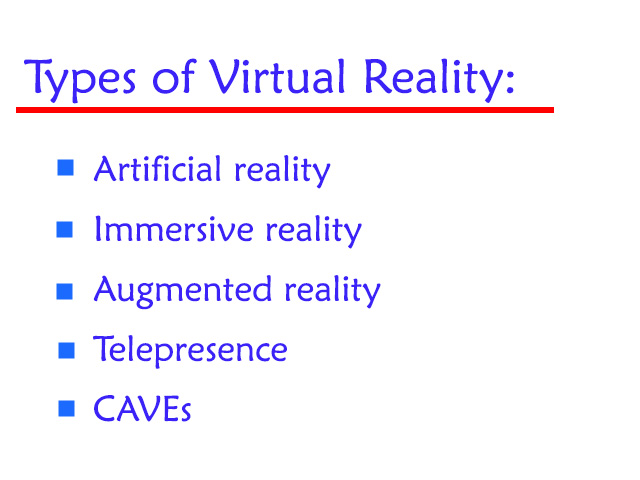 Several distinct types of virtual reality have emerged:
Several distinct types of virtual reality have emerged:
- Artificial reality = complete unencumbered full-body multisensory participation in computer events.
- Immersive reality = eyes and ears or other body sensors are isolated from real environment and fed only information from the computer, providing a first-person interaction within the computer-generated world.
- Augmented reality = simultaneously receiving supplemental virtual data about the real world while navigating around in a physical reality.
- Telepresence = use of a robotic vehicle and viewing system to give a feeling of being present at remote real locations with the ability to manipulate objects at that remote location.
- CAVE (Cave Automated Virtual Environment) = introduced by the Electronic Visualization Laboratory at the University of Illinois in 1992; essentially rear-projection systems for three walls and a floor projected in stereo and viewed with stereo glasses. As a CAVE viewer moves, a location sensor tracks movement within the display boundaries, and the correct perspective and stereo projections of the environment move with and surround the viewer. It is total immersion so that when you look up you see virtual sky or down for ground; projection systems create surroundings that feel like walking into an enclosed space, without being physically linked to a device.
Virtual reality hardware and software:
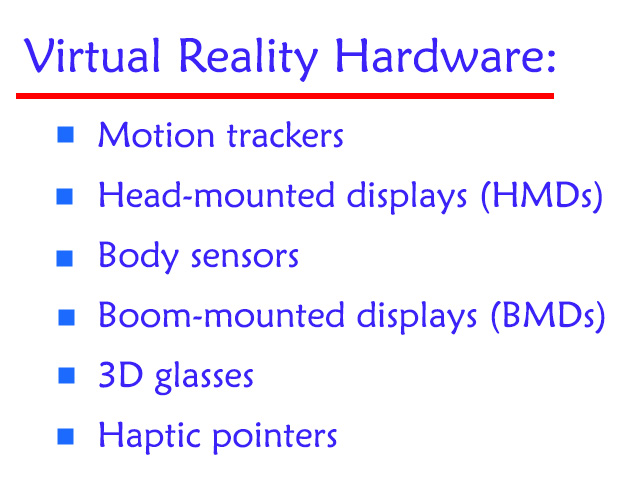 Fully immersive virtual reality experiences require a hardware platform with multimedia and fast graphics capabilities, interface devices such as instrumented clothing or head-mounted displays, associated motion tracking equipment, and VR software toolkits. Essential are a computer and VR software.
Fully immersive virtual reality experiences require a hardware platform with multimedia and fast graphics capabilities, interface devices such as instrumented clothing or head-mounted displays, associated motion tracking equipment, and VR software toolkits. Essential are a computer and VR software.
Sensors worn on or near the body enhance the virtual experience; they include: instrumented gloves to manipulate virtual objects and provide tactile feedback; wired clothing or bodysuits to translate full body movement into the virtual world; head-mounted displays for creating a sense of presence in a virtual setting.
Tracking devices find your position and orientation in the real world and relate them to the virtual one. They vary widely in technology, form, and cost (from $600-$6,000), depending on the technology employed and whether they give 3dof or 6dof (e.g. those from Ascension, Shooting Star Technology, Logitech, SpaceTech, BioControl systems); and laser-based optical tracking systems from Spatial Positioning Systems go for $50,000-$70,000.
The most common device is the head-mounted display (HMD), usually in the form of a helmet with a tiny computer monitor for each eye. There are a wide range of HMDs (from $700 to $50,000) depending on resolution, field of vision, lens quality, degrees of freedom, tracking technology, sound quality, ergonomics, and head positioning tolerances. The trade off is either a wider field of view with lower apparent resolution or a narrow field of view with higher apparent resolution. Low-end HMDs include Virtual I/O I-glasses ($800), the CyberMaxx from VictorMaxx technologies ($889), and Forte VRX-1 ($995). Other examples are the VIM-HMD from Kaiser Electro-Optics, Visette 2 from Virutalitey, and VR4 from Virtual Research. The HRX HMD sells for $49,000.
Boom-mounted displays are offered from Fakespace or LEEP technologies, essentially similar to HMDs but mounted on booms for ease of movement and less weight on the head.
Also available are eye trackers, goggles, and 3D glasses (with names like CrystalEyes and Cypbereye). Virtual screens with one lens placed 25cm in front of one eye act like a monitor while users can look away into physical space at same time. Instrumented gloves with sensors such as the DataGlove (a handtracking device created by Jaron Lanier of VPL, for $8800), came to the mass market as the PowerGlove by Mattel for use with Nintendo video games. Now several varieties of gloves are available from $500 to the 5th Glove, by Fifth Dimension Technologies, and the Dexterous Hand Master from EXOS, for $15,000. Also available is the partial or full body sensor or biosensor (to detect muscle activity, or eye movement) and 3Dof or 6Dof mouse; also used are joysticks or spaceballs from $70-1200; Force feedback (or haptic) sensors provide real-time feedback for a sense of touch and the sensation of holding, pulling, or feeling textures. And 3D sound devices from Crystal River Engineering, under names like Convolvotron, Beachtron, Acoustetron.
Popular VR software includes Virtus Walkthough, Virtus VRML ($99) and Virtus Walkthrough Pro ($495). Virtus Corporation desktop software allows the user to build anything that has volume and then walk through what has been built, but offers no sound and the palette is limited to 256 colors. VREAM virtual reality development system (VRCreatror - $495) is more expensive but supports datagloves, head trackers, and goggles. Virtual Reality Studio from Domark Software (San Mateo CA) builds 3D environments and allows walkthroughs or animations, and also supports sound; one version sells for under $100. ParaGraph developed Virtual Home Space Builder ($49) with 50 pre-built spaces and capability to attach multimedia files to its 3D objects.
Higher-end software from Divison is a C-language world toolkit for a Pentium platform $50,000-$200,000; WorldToolKit and WorldUp by Sense8 (Mill Valley CA, sell for $3500--$12,000) for UNIX or Windows NT; and there is VistaPro by Virtual Realities Laboratories (San Luis Obispo CA). Other options include Open/Inventor ($1395) for Windows NT, with Visual C++; Superscape VRT for creating and editing worlds and objects, includes a bitmap editor for textures, animation and morphing editor, and its own programming language ($4000); and Microcosm from VPL Research for the Mac platform runs for about $75,000. Of course, this is all out of date as of now. VRML (Virtual Reality Modeling Language) allows virtual environments to run on PCs, from CDs, or over the Internet.
